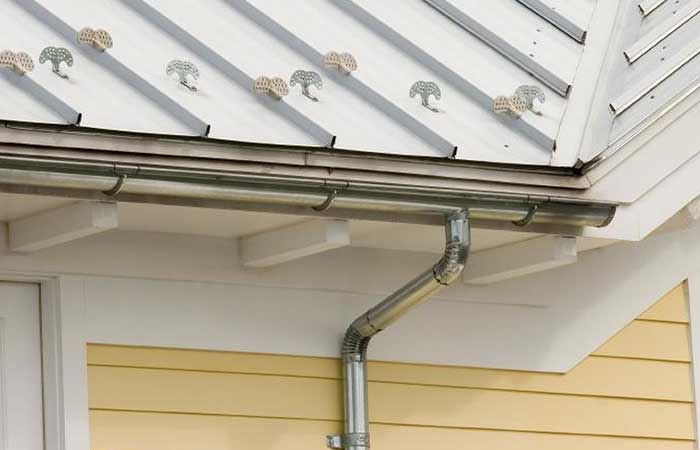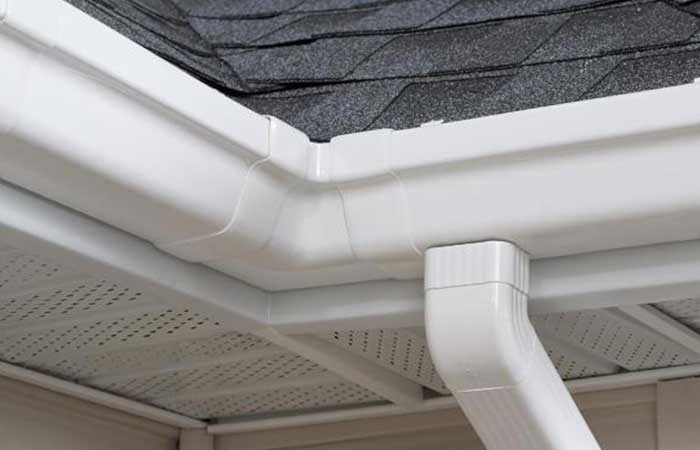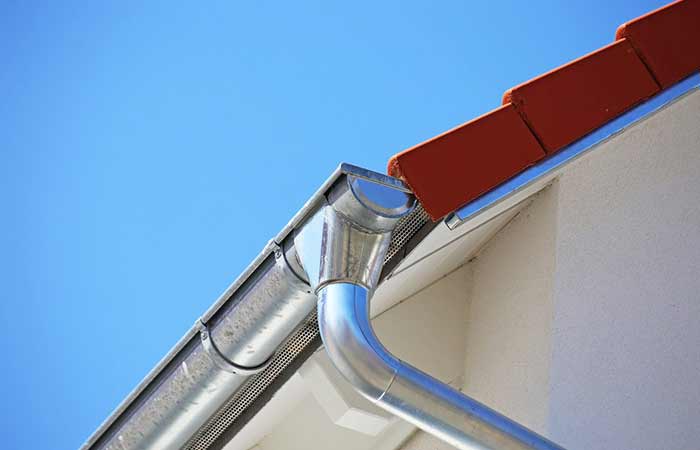The longevity of your gutters will depend on the type of materials they’re made of, the weather in the area, the maintenance procedures among other aspects. For example, copper gutters last longer than aluminum gutters while gutters in places with high amounts of rainfall and dirt in the air will last for a shorter period of time compared to those with less rainfall and airborne dirt.
Aluminum gutters, which are among the most common, last for about 20 years. Under the same conditions, gutters made of copper will last for about 50 years. It all depends on how you take care of them and the prevailing weather conditions. In some places for example, gutters will last much less given that they have acid rain, lots of leaves and other types of dirt in the air.
To take care of your gutters and make them last longer, you should clean them at least twice a year, ensure they’re professionally installed and repair the areas with issues as soon as you observe them. Cleaning your gutters isn’t hard and may not need the input of an expert. However, for gutters from the first floor upwards, you might need an expert as reaching and working on them can be hazardous.
Gutter Durability
If you’re wondering how long your gutters will last, then this guide is what you need:
Aluminum
Aluminum gutters will last about 20 years with proper care and maintenance.

Vinyl
Vinyl gutters last about as long as aluminum ones and that’s about 20 years or more.

Copper
Copper gutters are among the most durable and last for up to 50 years with proper maintenance and care.
Plastic
Plastic gutters also last for about 20 years although recent progress in the manufacturing process has made them much better with an expected lifespan of 30 years.
Steel
Steel gutters, on the other hand, last for up to 25 years with good care. Although steel is stronger than the other materials, it still doesn’t outlast copper as copper doesn’t rust like steel and other metals. Instead, copper makes a patina and doesn’t get worn out.
No matter the type of gutters you get, they’re supposed to protect your house from damage by rain water and snow. Without gutters or with poorly maintained ones, it becomes easy for water to cause erosion on the soil below, damage to the wall and the fascia board and even ice damming on the roof.

Factors that will determine how long Gutters Last
The durability of your gutters depends on the following aspects:
Material the gutter is made of
The materials used to make gutters determine how tough and durable they are against the weather. In similar weather conditions, for example, copper gutters will outlast aluminum given that copper is a more durable material when compared to aluminum. Already, copper gutters outlast aluminum gutters by around 30 years in similar weather conditions and maintenance routines.
The reason for such a disparity is how each material fares on when exposed to the elements like roof gutters are. The rates of corrosion, oxidation and response to the sun differ among these materials. Against the sun, for example, plastic is the worst as long term exposure makes it brittle and easy to break.
Maintenance routine
How much you inspect and maintain your gutters determines how long they will last. Gutters can develop blockages, rust, breakages and other types of issues which makes them operate outside their optimal conditions. A clog, for example, makes the gutter heavy with water and dirt which can easily lead to its breakage.
Without correcting blockages early, cleaning the rust away and solving other issues on time, the gutters won’t last that long. In fact, the gutters will quickly deteriorate. They might need spares in some cases and total replacement in others.
In most cases, the best routine is to clean the gutters at least two times each year. This, however, applies only to the areas without much rain or dust and other types of debris.
In other cases, the cleaning routine for your gutters should be much more frequent. For example, if you have trees around, you should clean the gutter each time they start shedding their leaves.
Leaves on the ground mean there are leaves on your roof and the gutter as well. These will easily cause blockages to the gutter and lead to more serious issues if not rectified on time.
A good number of maintenance routine practices can be carried out without an expert. Others, however, will need a qualified expert to carry them out. These include changing the slope of the gutter or changing them altogether.
Weather conditions
The weather is a major determinant of how long your gutters and roof in general will last. In an area with mild weather, the gutters will last the longest. This is an area with little rain, little ice and little sunlight. It would also have weaker winds which won’t blow dust and other damaging objects against the gutters.
However, given the same type and level of maintenance, gutters in harsher weather will last much less. If there’s a lot of rain, the gutters are exposed to more corrosion especially the metal ones. If there’s acid rain, the gutters will last the least as they’ll be quickly corroded by the rain.
Ice and snow add weight to the gutters which can tamper with their structural integrity. If too heavy, snow and ice can break the gutters needing extensive repair in the process. With sunlight, the more there is the less the gutters will last. Sunlight damages plastic gutters faster than the other materials. You should thus only use plastic gutters in places with little sunlight to give them a longer life.
Quality of installation
Gutters need to have a specific slope to allow water flow to the downspouts when it’s raining. Without this slope, water will remain stagnant in some parts of the gutter. Sedentary water on the gutter accelerate the rate of damage and can lead to rust and even leaks in the joints.
Another aspect about the installation of the gutters is the position and frequency of the downspouts. In most cases, downspouts on gutters are located in the back corners of the house which is a good thing as it’s aesthetic as well as being functional. In some cases, however, you might need a downspout in the straight part of the roof. This can be the case when that side of the roof is a long one and can’t hold the weight of the water when it’s raining heavily. Rather than letting it bend under the weight of the water, a drain will help drain the water away.
Always keep these aspects in mind when choosing the gutters for your house. Being a technical job, you need an expert to install them for the best results.
Signs that your gutters need repairs or replacement
If you inspect your gutters and observe any of the following signs, you need to have them repaired or even replaced:
- When the gutters are directing the water towards rather than away from the foundation of your house. Left on their own, such gutters will eventually lead to the weakening of the foundation with more serious consequences such as a collapsed house in the long term.
- Wetness on the foundation can lead to moss and mildew in the foundation of your house. This spoils the air quality and weakens the foundation as well.
- Nails and fasteners on the ground mean that the roof or gutter is loose or even rotting and needs to be addressed as soon as possible.
- If you notice that the gutters are loose and hanging on one side rather than being level. Also, if the gutters are hanging to the outside or are bent instead of being straight, it means they’re compromised structurally.
- There is water standing in the gutters. Water in the gutters needs to flow to one side and not be in one location. It could mean there a poor slope or blockage keeping the water from flowing.
- If you find water in the walls of the basement, there’s a big possibility that the gutters are leaking it very close to the wall rather than away from it.
- If you notice rust, rotting or peeling paint in the home. This means that water is flowing down the wall and into the fascia board and other areas. The gutters could be bent or clogged in a part of it.
- Water channels away from the wall leading to the nearby areas is a sign that water is flowing down the wall in significant amounts.
- Your gutters may have holes, broken areas, disjointed parts and rusty areas to show they’re not in their best condition.
- Any visible gaps between the sections of the fascia board and the gutters, or between parts of the gutter.
Any one or several of these signs should alert you to rectify the underlying issue before it’s too late.
Tips to make your Gutters last longer
No matter the material your gutters are made of, you can make them last longer with the following tips:
- Clean them as frequently as possible.
- Remove leaves and twigs from the roof and gutters as soon as possible.
- Go for larger downspouts as they allow for a faster draining of the water in the gutter. This prevents excessive weight and keeps the gutters in good shape.
- Install leaf guards to prevent the accumulation of leaves on the roof.
- Choose seamless gutters over sectional ones. Sectional gutters easily develop leaks and breaking points as compared to seamless ones which don’t have such issues. Sectional ones also take long to install as they have more pieces to work with.
The secret to good quality gutters that will serve you for long is proper maintenance and always making inspections to find the problem areas on time.
More on Gutters
- Why are Gutters Important & When are Gutters not Necessary?
- Do Gutters Cause Ice Dams?
- How to Fix a Sagging Gutter
- How to Install Gutters Without Fascia Board
- Vinyl vs Aluminum vs Steel Gutters: Differences, Pros & Cons
- Rain Gutter Alternatives, Low Maintenance, Cheap & DIY Options
- Rain Diverter vs Gutter-Differences & Similarities
As an Amazon Associate, we earn from qualifying purchases. Details here
